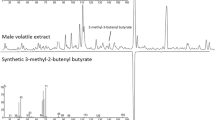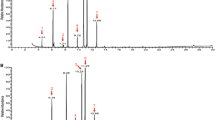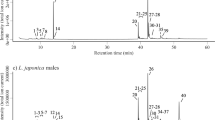Abstract
The bean bug,Riptortus clavatus lays scattered eggs (as opposed to the egg masses of pentatomids) on host as well as nonhost plants. Therefore, the first feeding stage (second-instar) nymphs emerging from eggs laid on nonhost plants need a signal that enables them to locate a food source at the lowest energy cost. Male-released (E)-2-hexenyl (E)-2-hexenoate, (E)-2-hexenyl (Z)-3-hexenoate, and myristyl isobutyrate play the double role of attractant pheromone for adults as well as aggregation pheromone, which enables the second-instar nymphs to find the host food plant. These male-specific semiochemicals are released only when foodstuff is available. On the other hand, females ofOoencyrtus nezarae, the most effective parasitoid of the host in Kumamoto, Japan (where the field experiments were conducted), utilize these semiochemicals as kairomones in order to locate the potential host community. Field experiments revealed that the synthetic pheromone rivaled 10 live males in the attraction of adults and second-instar nymphs. Captures of the egg parasitoidO. nezarae females in cylindrical sticky traps were significantly higher in traps baited with the synthetic semiochemicals than in control traps. The number of females captured was significantly higher than the number of males, although the captures in the sticky suction trap system revealed that the populations of male and female were not significantly different.
Similar content being viewed by others
References
Aldrich, J.R., Kochansky, J.P., andAbrams, C.B. 1984. Attractant for a beneficial insect and its parasitoids: Pheromone of the predatory spined soldier bug,Podisus maculiventris (Hemiptera: Pentatomidae).Environ. Entomol. 13:1031–1036.
Aldrich, J.R., Oliver, J.E., Lusby, W.R., Kochansky, J.P., andLockwood, J.A. 1987. Pheromone strains of the cosmopolitan pest,Nezara viridula (Heteroptera: Pentatomidae).J. Exp. Zool. 244:171–175.
Borges, M. 1987. Chemical communication in the green stink bug.Nezara viridula (L.) (Hemiptera: Pentatomidae). PhD thesis. University of Southampton, Southampton, UK.
Brézot, P., Malosse, C., andRenou, M. 1993. Study of the attractivity of the male pheromone inNezara viridula L. (Heteroptera: Pentatomidae).C.R. Acad. Sci. Ser. III 316:671–675.
Harris, V.E., andTodd, J.W. 1980. Male-mediated aggregation of male, female and 5th-instar southern green stink bugs and concomitant attraction of a tachnid parasite,Trichopoda pennipes. Entomol. Exp. Appl. 27:117–126.
Higuchi, H. 1993. Seasonal prevalences of egg parasitoids attackingPiezodorus hybneri (Heteroptera: Pentatomidae) on soybeans.Appl. Entomol. Zool. 28:347–352.
Leal, W.S., andKadosawa, T. 1992. (E)-2-Hexenyl hexanoate, the alarm pheromone of the bean bugRiptortus clavatus (Heteroptera: Alydidae).Biosci. Biotech. Biochem. 56:1004–1005.
Mattiacci, L., Vinson, S.B., Williams, H.J., Aldrich, J.R., andBin, F. 1993. Long-range attractant kairomone for egg-parasitoidTrissolcus basalis, isolated from defensive secretion of its host,Nezara viridula.J. Chem. Ecol. 19:1167–1182.
Nakamori, H., Hokyo, N., andLeal, W.S. 1994. Proceedings, 38th Annual Meeting of the Japanese Society of Applied Entomology and Zoology, Tokyo, March 28–31. p. 140.
Numata, H., Matsui, N., andHidaka, T. 1986. Male adults attract conspecific adults in the bean bug,Riptortus clavatus Thumberg (Heteroptera: Alydidae).Appl. Entomol. Zool. 25:144–145.
Struble, D.L., andArn, H. 1984. Combined gas chromatography and electroantennographic recording of insect olfactory responses, pp. 161–178,in H.E. Hummel and T.A. Miller (eds.). Techniques in Pheromone Research. Springer-Verlag, Tokyo.
Whitmann, D.W. 1988. Allelochemical interactions among plants, herbivores, and their predators, pp. 11–64,in P. Barbosa and D. Letourneau (eds.). Novel Aspects of Insect-Plant Interactions. John Wiley & Sons, Singapore.
Author information
Authors and Affiliations
Rights and permissions
About this article
Cite this article
Leal, W.S., Higuchi, H., Mizutani, N. et al. Multifunctional communication inRiptortus clavatus (Heteroptera: Alydidae): Conspecific nymphs and egg parasitoidOoencyrtus nezarae use the same adult attractant pheromone as chemical cue. J Chem Ecol 21, 973–985 (1995). https://doi.org/10.1007/BF02033802
Received:
Accepted:
Issue Date:
DOI: https://doi.org/10.1007/BF02033802




